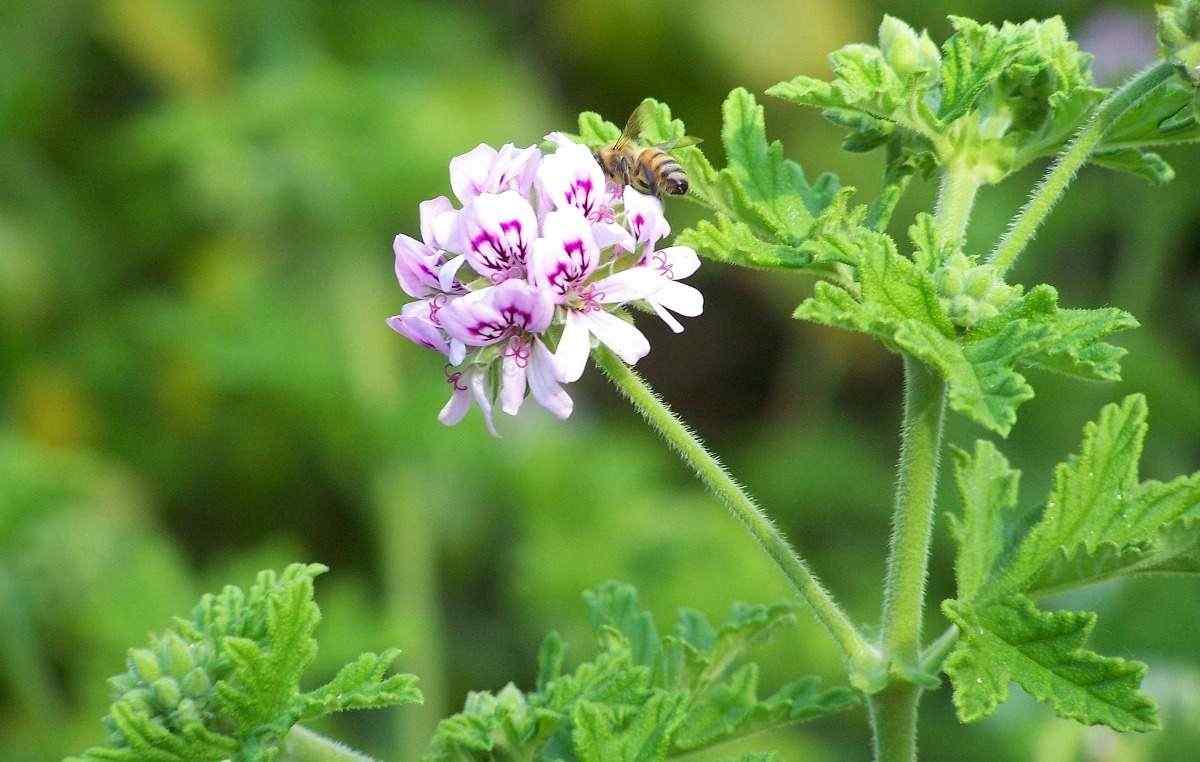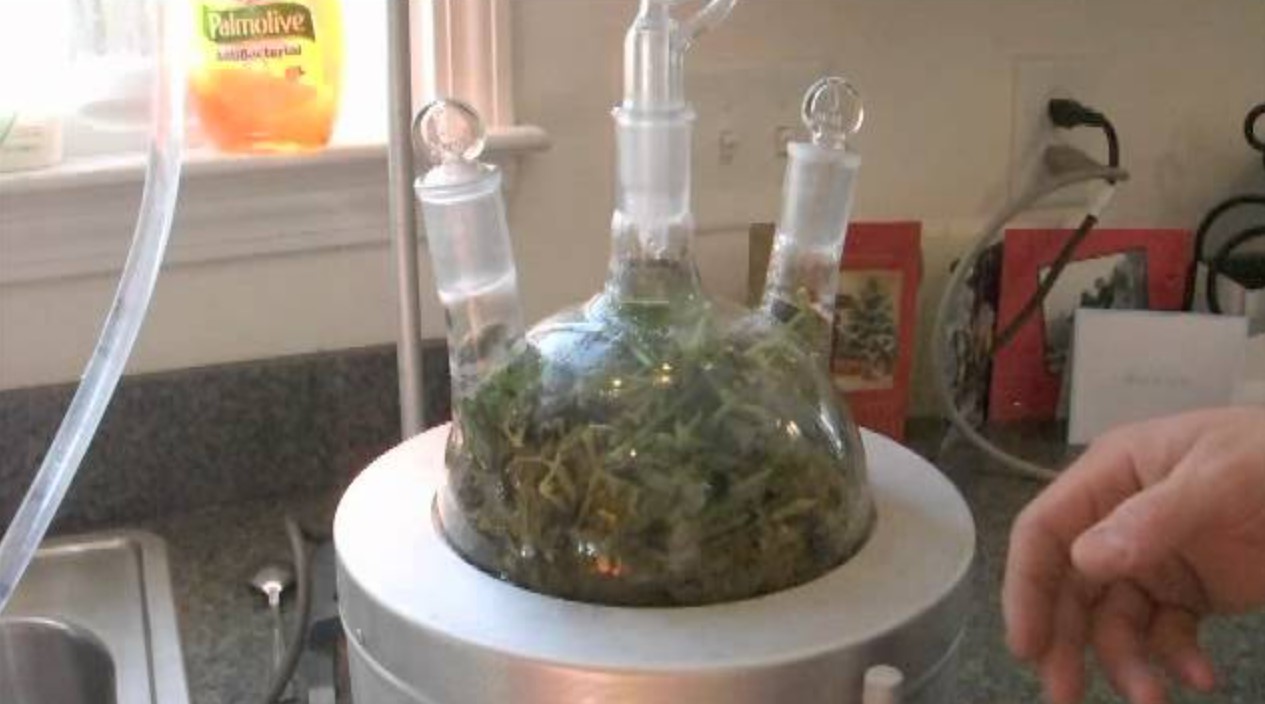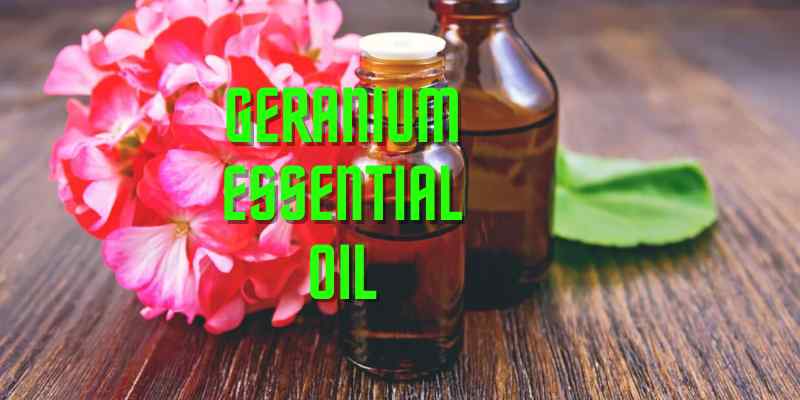Geranium is a genus of flowering plants with over 400 species, also refer as storksbills or cranesbills. It is an ornamental and decorative plant that you may find in most gardens. It has cleft leaves that may resemble your palm and produces colorful flowers like white, pink, red, scarlet, crimson, and purple with a sweet roselike smell.
Apart from its aesthetic application, Pelargoniums have some elements that can benefit the human body. To capture those elements efficiently, they mostly use leaves and stalks to extract them. The essential oil has a vital role in the perfume and cosmetic industry. In the following discussion, we will bring everything about the storksbills plant and Geranium essential oil as detailed as possible.
Page Contents
What is Geranium essential oil?
Geranium is a flowering plant that provides vibrant, colorful flowers with beautiful smells. Besides its ornamental use, some part of the plant goes through steam distillation to extract pelargoniums essential oil.
After stream distillation of leaves and stems, it provides an olive-green or yellowish essential oil, famous for its rose oil-like smells. A significant part of storksbills oil goes to the perfume industry. Besides, the essential oil is well regarded for its other uses, like skin care products, hair care, aroma therapy, etc.
Moreover, the antibacterial, anticandida, and anti-inflammatory properties make it one of the most popular essential oil.
History of Geranium oil and Cultivation

Geranium is native to subtropical South Africa. For a long time, pelargoniums was limited to decorative bedding and greenhouse plant. Apart from its aesthetic use, this plant cultivation started in the 17th century. The French bought storksbills from South Africa to France and started cultivating them for essential oil.
Later, they export geranium cultivation to their colonies in Africa. At the time, it’s cultivation spread in Italy, Morocco, Congo, Algeria, Egypt, Madagascar, etc. The initial cultivation was more comprehensive than a handful of species, and there were multiple types of oil without a fixed standard. Nowadays, you may find only a handful of species are preferred to cultivate commercially, including hybrids like Pelargonium asperum.
Geranium can grow in wide varieties of land, like tropical, sub-tropical, and temperate climates. For better yield, 16-24°c is the best. Moreover, storksbills cultivation requires 4-6 hours of sunlight, regular irrigation, and good drainage.
The global demand for storksbills oil is more than 600 tonnes and is fulfilled mainly by countries like China, Morocco, South Africa, Egypt, etc.
Geranium oil Features
| Serial | Features | Description |
| 1. | Botanical Name | Pelargonium graveolens / Pelargonium asperum |
| 2. | Plant Family | Geraniaceae |
| 3. | Common Method of
Extraction |
Steam distillation of wilted leaves |
| 4. | Plant Part Typically Used | Leaves |
| 5. | Color | The color of the oil depends on the area where the plant is grown. Oil from china is mostly pale olive-green. Besides, oil from Egypt is generally pale yellow. |
| 6. | Consistency | This is a thin oil |
| 7. | Perfumery Note | It belongs to the middle notes of perfumery |
| 8. | Strength of Initial Aroma | It has a powerful aroma |
| 9. | Aromatic Description | Geranium Essential Oil has a floral, fresh, mildly fruity, and sweet smell. |
| 10. | Major Constituents | Geraniol (20.81%), Linalol (11.94), Citronellyl formate (8.04), Citronellol (25.55%), Isomenthone (7.59%), Geranyl Formate, and 10-epi-Gamma-Eudesmol. |
Geranium oil vs. rose geranium oil
There are two species of geranium family most commonly cultivated for oil. One called “Pelargonium graveolens” is genetically pure, and the oil extracted from it is called geranium oil. The essential oil from the pure breed plants is mild, fresh, floral, sweet, and fruity.

On the other hand, Pelargonium asperum is a hybrid and provides some solid aromatic essential oil very close to rose with a mild minty tone. The essential oil from the later species is designed to cultivate commercially. It is also used as a substitute for highly expensive rose essential oil called rose geranium, the most commonly available and used variant in the perfume and cosmetic industry.
You may find both essential oils in the market, but the latter is comparatively common and easy to find in your nearest stores.
How to make geranium oil at home

The most common way to extract something from storksbills leaves is to infuse it in a carrier oil, which is easy, and you may already be familiar with the process. However, it gives you some storksbills essence, but for extracting essential oil, you must go through the whole stream distillation process. It is quite a technical and sophisticated process but achievable with proper equipment and knowledge. If you want to distill geranium essentials, follow the steps we discuss below.
Harvest the Plant
For the best fragrance, you must collect mature yellowish or deep green leaves. It will yield more oil in quantity along with excellent aromatic quality.
Dry Thoroughly
You must dry it steadily and thoroughly. If you dry your leaves properly, you can fit more material in the heating chamber and get more oil in every batch.
Boiler Preparation
Before starting a fresh batch, you must clean the boiler and add an adequate amount of clean water based on the instruction in the manual. It will produce the steam that will do the distillation work.
Add Dried Leaves to secondary Still
Put your properly dried component in the still chamber. Do not break or cut the leaves because, in the breaking process, you may lose some valuable oil.
Heating
Then you start to heat the boiler. It is best to set the boiler at 150℉ for the best result. The stream will go through, still filled with dried leaves, and later through the condenser. Set a pot to collect the final liquid, a mix of essential oil and water.
Separate the Oil and Hydrosol
After collecting the mixture, let it rest for 12 hours. Then the oil and hydrosol form two separate layers. Darin the oil and hydrosol in two separate containers. For purer oil, you can repeat the process couple more times. Finally, store the end product in a cool and dry place.
Alternatives to Geranium botanic oil
Essential oils are one of the oldest compounds we adore and utilize. Some are very old in origin, and some are comparatively new, but all have something in common in attributes and properties.
Storksbills oil is rich in fragrance and has excellent properties for skin and hair care functions. Many essential oils share similar characteristics and can be used as a substitute. Such as, you can use Chamomile, Lavender, Rosemary, and rose essential oil for perfumery similarly.
For anxiety and stress relief properties, Bergamot, Lavender, Lemon, Neroli, Sandalwood, etc., can be good alternatives. They have similar functions and a few common chemicals, such as geranium oil.
Chamomile, Lavender, and Cedarwood inhalation can help your sleeping trouble and pelargoniums. Besides, Lavender, Sandalwood, Eucalyptus, or Patchouli can come to your aid with skin-related issues. They can give you similar benefits and, in some cases, even more.
If you want to resolve your hair-related problems, Rosemary, Cedarwood, Thyme, or Clary oil can become your best alternative. Apart from these significant benefits, you may find essential oil with some minor use as an alternative to pelargoniums oil.
How to use geranium essential oil
Essential oils application follows a particular pattern. For solid and effective aromatic properties, you must inhale the diluted oil or oil mixed with vapor. In some cases, raw oil is safe to breathe in, but storksbills oil is more potent or active to use in raw form.
You can use geranium oil in aromatherapy as well. In aromatherapy, you must take a few drops of oil in a cotton ball and place them where you can breathe them most comfortably. Moreover, you can use a humidifier to defuse the scent all over the room and enhance the effect.
Skin massage is an excellent way to utilize the benefits of pelargoniums oil. For that, you have to pour a few drops of oil and dilute them in a carrier like an argan oil, coconut oil, jojoba oil, olive oil, apricot kernel oil, etc. and use them to massage your skin. You can use a similar approach to massage your scalp.
Another easy but effective way to use storksbills oil is to mix it with your skin or hair care product and apply them as usual. It will enhance the effect of those cosmetics.
Benefits and Uses of Geranium oil
There are a lots of benifit of this botanic oil. It is very good for health and mind. Hoeever here are the best 12 benifits and uses of this oil.
1. Reduce Wrinkle
 Regular geranium oil with an anti-oxidant like Linalol can tighten your skin by recovering the skin cell. It appears as an age-reducing serum without any harmful effects. For the result, you have to add 2-3 drops of oil to your regular body lotion and apply them.
Regular geranium oil with an anti-oxidant like Linalol can tighten your skin by recovering the skin cell. It appears as an age-reducing serum without any harmful effects. For the result, you have to add 2-3 drops of oil to your regular body lotion and apply them.
2. Reduce Neurodegenerative Effect
Citronellol in the storksbills oil can stop nitrous oxide production and reduce neuroinflammation-related cell death in the brain, which can be an effective countermeasure for neurodegenerative disorders like Alzheimer’s disease, Parkinson’s disease, multiple sclerosis, etc.
3. Relieve Stress, Anxiety, and Depression
Citronellol is one of the key components in aromatherapy and geranium has enough of them. Aromatherapy can reduce or ease stress, anxiety, and depression. Aromatherapy with Citronellol-rich storksbills oil can be much more effective against those discussed problems.
4. To Treat Diabetes
In Tunisian folk medicine, pelargoniums oil has been used to treat hyperglycemia. According to a study on animals, oil injection can reduce blood sugar and help to reduce diabetes levels. Although geranium oil still is not for oral consumption, in the future, it may use in the production of diabetes medication.
5. Antimicrobial Properties
Many skin or scalp-related problems are related to different microbes. Storksbills oil is an excellent antimicrobial agent due to the presence of Linalol. Linalol in the oil can reduce the microbial effects and prevent bat microbes from growing on your skin and causing problems like acne and other infections.
6. Insect and Other Bugs Repelling
If you do not like a harmful inorganic pest or bug repellent, you must use pelargoniums oil as an alternative. A good amount of Geraniol in botanic oil makes it an excellent non-toxic insect or pest repellent and works as an air freshener.
7. Aromatherapy
Citronellol is the reason behind the beautiful smells of storksbills oil. It is also one of the most preferred substances in aromatherapy. You can have the best aromatherapy by using geranium oil. You can leave a few drops of oil on a cotton ball or in the humidifier and relax in your comfort zone. It will reduce fatigue, stress, and anxiety and improve cognitive function.
8. Anti-fungal activities
You can use the essential oil for treating fungus infections. A regular oil application can prevent fungus from attacking your skin because pelargoniums oil is rich in citronellyl formate, which is well known for its anti-fungal properties.
9. Cold, Flu, and other Respiratory Infections Killer
Almost all suffer from cold, flu, and respiratory infection. Instead of biomedicine, some of them like to use something organic and sourced directly from nature, like storksbills oil. The presence of Citronellol in the oil makes it perfect for easing the suffering from those problems.
10. Digestive and Intestinal Problems
Geranium oil is also suitable for digestive and intestinal problems. It retains a fair amount of Citronellol, a proven compound for solving digestive and intestinal problems by preventing harmful bacterial growth. Moreover, it can eliminate different kinds of worms in your intestine and give you a healthy digestive system.
11. Wound care and Pain Relief
Storksbills oil can stop bleeding on the minor wound and speed up the healing process due to its antimicrobial properties. In some folk medicine, pelargoniums oil has long been a pain reliever and sedative. They have also used it for wounds, fever, and hemorrhoid treatment.
12. Anti-inflammatory Agent
One of geranium oil’s major compounds is Linalol, an effective anti-inflammatory agent. You can use geranium oil to treat swallowing and other inflammatory problems.
Side Effects of Geranium Oil
These Beneficial essential oil sometimes causes unwanted harm. Not all users experience similar side effects, but for those unlucky few who are not compatible with geranium oil, we will briefly discuss some common side effects below.
- Some essential oil can alter the hormonal balance and disrupt the body’s regular function. During the first few months of pregnancy, those changes can be harmful. Geranium oil is not out of those effects and should be avoided.
- Some users may feel a rush or burning sensation while using pelargoniums oil. They can either avoid or use the oil after diluting it into a carrier oil.
- Storksbills oil occasionally disrupts the normal process of hormonal secretions of hormones. That can disrupt the usual bodily functions.
Where to buy geranium essential oil
The best source for pelargoniums oil is your nearest Volant shops that sell pure, reliable, and purely distilled oils. However, not all consumers are blessed with such shops near their residences. Reliable online market platforms like Amazon can come to your salvation.
For online purchases, you must get help from some expert on essential oil or consult someone who has recently purchased from those stores. Detailed consumer reviews give you an idea of choosing the best product.
If you want to rely on something other than online service, then stores like DoTERRA can be another option. Although they will ensure a good service, you must spend a little more than usual. For more reliable purchases, you can go to the Pharmacies.
All of the sources we have discussed are merely your option of place. To buy pure, reliable, and effective essential oil, you must gather some knowledge about some reliable brands like Brookside, Elke, Orion, Rozanne, Mavis Simpson, Patricia, Sweet Heidy, etc.
Quick facts
- Geranium essential oil is one of the least-known oil with numerous benefits.
- The use of this African plan has a deep root in history as far back as the time of Pharaoh.
- It is a vital component in the modern perfume industry.
- The smell of pelargoniums resembles rose but has a minty note to it, which makes it unique.
- A hybrid variant called Pelargonium graveolens is most common in commercial cultivation, and oil from it is called rose geranium oil.
- The garden and oil-producing variants of storksbills are entirely different from each other.
- It was the French who first commercialized pelargoniums cultivation.
Final Thought
Pelargoniums is one of the most commonly used essential oils, yet we know little about it. The advent of storksbills cultivation has a colonial past, which spread the cultivation all over the world and made the ornamental plant into one of the major cash crop thanks to the perfume and cosmetic industry.
The demand for geranium essential oil has rapidly increased in the past century. India feeds 149 tonnes of 600 tonnes annual yield in their perfume and cosmetic industry. In contrast, their domestic production is as low as 5 tonnes.
The increasing demand outpaced the producer, and a new scope of cultivating geranium is open. It can become a high-yielding cash crop of the 21st century and simultaneously benefit both the producer and consumer.

